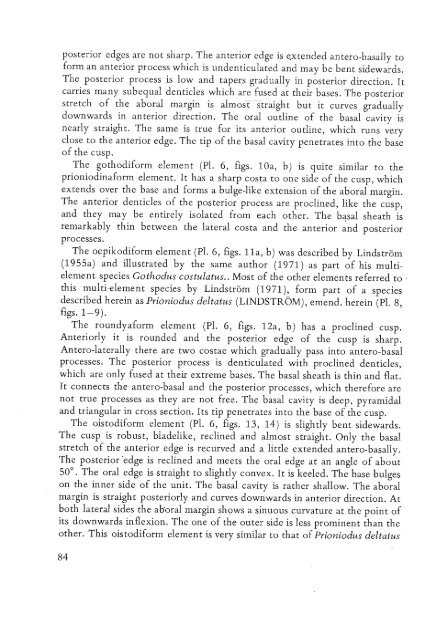UTRECHT MICROPALEONTOLOGICAL BUllETINS
UTRECHT MICROPALEONTOLOGICAL BUllETINS
UTRECHT MICROPALEONTOLOGICAL BUllETINS
Create successful ePaper yourself
Turn your PDF publications into a flip-book with our unique Google optimized e-Paper software.
posterior edges are not sharp. The anterior edge is e.xtended antero-basally to<br />
form an anterior process which is undenticulated and may be bent sidewards.<br />
The posterior process is low and tapers gradually in posterior direction. It<br />
carries many subequal denticles which are fused at their bases. The posterior<br />
stretch of the aboral margin is almosTstraight but it curves gradually<br />
downwards in anterior direction. The oral outline of the basal cavity is<br />
nearly straight. The same is true for its anterior outline, which runs very<br />
close to the anterior edge. The tip of the basal cavity penetrates into the base<br />
of the cusp.<br />
The gothodiform element (PI. 6, figs. lOa, b) is quite similar to the<br />
prioniodinaform element. It has a sharp costa to one side of the cusp, which<br />
extends over the base and forms a bulge-like extension of the aboral margin.<br />
The anterior denticles of the posterior process are proclined, like the cusp,<br />
and they may be entirely isolated from each other. The bCl-salsheath is<br />
remarkably thin between the lateral costa and the anterior and posterior<br />
processes.<br />
The oepikodiform element (PI. 6, figs. lla, b) was described by Lindstrom<br />
(1955a) and illustrated by the same author (1971) as part of his multielement<br />
species Gothodus costulatus .. Most of the other elements referred to '<br />
this multi-element species by Lindstrom (1971), form part of a species<br />
described herein as Prioniodus deltatus (LINDSTROM), emend. herein (PI. 8,<br />
figs. 1-9).<br />
The roundyaform element (PI. 6, figs. 12a, b) has a proclined cusp.<br />
Anteriorly it is rounded and the posterior edge of the cusp is sharp.<br />
Antero-Iaterally there are two costae which gradually pass into antero-basal<br />
processes. The posterior process is denticulated with proclined denticles,<br />
which are only fused at their extreme bases. The basal sheath is thin and flat.<br />
It connects the antero-basal and the posterior processes, which therefore are<br />
not true processes as they are not free. The basal cavity is deep, pyramidal<br />
and triangular in cross section. Its tip penetrates into the base of the cusp.<br />
The oistodiform element (PI. 6, figs. 13, 14) is slightly bent sidewards.<br />
The cusp is robust, bladelike, reclined and almost straight. Only the basal<br />
stretch of the anterior edge is recurved and a little extended antero-basally.<br />
The posterior 'edge is reclined and meets the oral edge at an angle of about<br />
50°. The oral edge is straight to slightly convex. It is keeled. The base bulges<br />
on the inner side of the unit. The basal cavity is rather shallow. The aboral<br />
margin is straight posteriorly and curves downwards in anterior direction. At<br />
both lateral sides the ahoral margin shows a sinuous curvature at the point of<br />
its downwards inflexion. The one of the outer side is less prominent than the<br />
other. This oistodiform element is very similar to that of Prioniodus deltatus
















